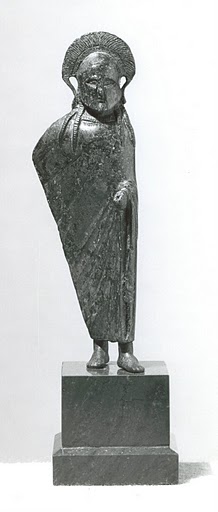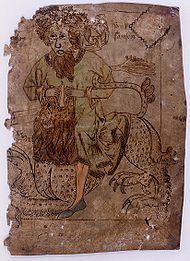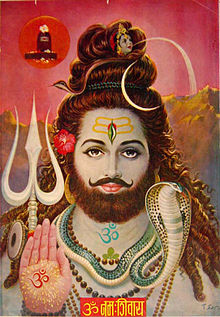Dreadlocks: Difference between revisions
No edit summary |
No edit summary |
||
| Line 4: | Line 4: | ||
==History== |
==History== |
||
| ⚫ | |||
[[File:Pictishstone.jpg|thumb|left|[[Pict]]ish carved stone from medieval [[Scotland]] depicting [[Samson]] with locked hair. In the [[Book of Judges]] 16:19 of the [[Old Testament]], Samson loses his strength when his seven dreadlocks are cut from his head.]] |
[[File:Pictishstone.jpg|thumb|left|[[Pict]]ish carved stone from medieval [[Scotland]] depicting [[Samson]] with locked hair. In the [[Book of Judges]] 16:19 of the [[Old Testament]], Samson loses his strength when his seven dreadlocks are cut from his head.]] |
||
| ⚫ | |||
The first known examples of dreadlocks date back to [[North Africa]] and the [[Horn of Africa]]. In [[ancient Egypt]] examples of Egyptians wearing locked hairstyles and [[wig (hair)|wigs]] have appeared on bas-reliefs, statuary and other artifacts.<ref>[http://www.freemaninstitute.com/Gallery/Egyp233_big_copy.jpg Image of Egyptian with locks.]</ref> Mummified remains of ancient Egyptians with locks, as well as locked wigs, have also been recovered from archaeological sites.<ref>[http://www.egyptianmuseum.com/article16_torlife.html Egyptian Museum -"Return of the Mummy.] ''Toronto Life - 2002''." Retrieved 01-26-2007.</ref> |
The first known examples of dreadlocks date back to [[North Africa]] and the [[Horn of Africa]]. In [[ancient Egypt]] examples of Egyptians wearing locked hairstyles and [[wig (hair)|wigs]] have appeared on bas-reliefs, statuary and other artifacts.<ref>[http://www.freemaninstitute.com/Gallery/Egyp233_big_copy.jpg Image of Egyptian with locks.]</ref> Mummified remains of ancient Egyptians with locks, as well as locked wigs, have also been recovered from archaeological sites.<ref>[http://www.egyptianmuseum.com/article16_torlife.html Egyptian Museum -"Return of the Mummy.] ''Toronto Life - 2002''." Retrieved 01-26-2007.</ref> |
||
Revision as of 13:43, 5 May 2015


Dreadlocks, also dreads or Jata (Hindi), are matted coils of hair. Most dreadlocks are usually intentionally formed; because of the variety of different hair textures, various methods are used to encourage the formation of locks such as backcombing. Additionally, leaving long hair to its own devices by not brushing or cutting the hair will encourage it to tangle together as it grows, leading to twisted, matted ropes of hair known as dreadlocks. The latter method is typically referred to as the neglect, natural, organic, or freeform method. A common misconception is that those who have dreadlocks do not wash their hair, but this is usually not the case. Many dreadlock care regimens require the wearer to wash their hair up to twice a week.[1]
History


The first known examples of dreadlocks date back to North Africa and the Horn of Africa. In ancient Egypt examples of Egyptians wearing locked hairstyles and wigs have appeared on bas-reliefs, statuary and other artifacts.[2] Mummified remains of ancient Egyptians with locks, as well as locked wigs, have also been recovered from archaeological sites.[3]
Maasai men found in the regions of northern Kenya claim that they have been wearing dreadlocks for as long as they have survived. According to their oral history, the Maasai originated from the lower Nile valley north of Lake Turkana (Northwest Kenya) and began migrating south around the 15th century, arriving in a long trunk of land stretching from what is now northern Kenya between the 17th and late 18th century. Even today, Maasai men can be found wearing their dreadlocks, with a tint of red color from the soil.
The Hindu deity Shiva and his followers were described in the scriptures as wearing "Jataa", meaning "twisted locks of hair". The Greeks and several ascetic groups within various major religions have at times worn their hair in locks, including the monks of the Ethiopian Orthodox Tewahedo Church, the Nazirites of Judaism, Qalandari Sufis, the Sadhus of Hinduism, and the Dervishes of Islam, among others. The very earliest Christians also may have worn this hairstyle. Particularly noteworthy are descriptions of James the Just, first Bishop of Jerusalem, who is said to have worn them to his ankles.[4]
Pre-Columbian Aztec priests were described in Aztec codices (including the Durán Codex, the Codex Tudela and the Codex Mendoza) as wearing their hair untouched, allowing it to grow long and matted.[5]
In Senegal, the Baye Fall, followers of the Mouride movement, a Sufi movement of Islam founded in 1887 by Shaykh Aamadu Bàmba Mbàkke, are famous for growing locks and wearing multi-colored gowns.[6] Cheikh Ibra Fall, founder of the Baye Fall school of the Mouride Brotherhood, popularized the style by adding a mystic touch to it. It's important to note that warriors among the Fulani, Wolof and Serer in Mauritania, and Mandinka in Mali and Niger were also known to have dreadlocks when old and cornrows when young for centuries.
By culture

There are many reasons among various cultures for wearing locks. Locks can be an expression of deep religious or spiritual convictions, ethnic pride, a political statement, or be simply a fashion preference. An alternative name for the style is locks (sometimes spelled "locs").
Africa and the Western World; Caribbean, North and South America
Members of various African ethnic groups wear locks and the styles and significance may change from one group to another.
Maasai warriors are famous for their long, thin, red locks. Many people dye their hair red with root extracts or red ochre. In various cultures what are known as shamans, spiritual men or women who serve and speak to spirits or deities, often wear locks. In Nigeria,[7] some Yoruba children are born with naturally locked hair and are given a special name: "Dada". Yoruba priests of Olokun, the Orisha of the deep ocean, wear locks. Another group is the Turkana people of Kenya. In Ghana, the Akan refer to dreadlocks as Mpɛsɛ, which is the hairstyle of Akomfoɔ or priests and even common people. Along with the Asante-Akan drums known as Kete drums, this hairstyle later adopted by Rastafarians, with its roots in Jamaica from the slave trade era.
Rastafari locks are symbolic of the Lion of Judah which is sometimes centered on the Ethiopian flag. Rastafari hold that Haile Selassie is a direct descendant of King Solomon and the Queen of Sheba, through their son Menelik I.
Hinduism

Similarly, among some Sadhus and Sadhvis, Hindu holy men and women, locks are sacred, considered to be a religious practice, an expression of disregard for profane vanity. The public symbol of matted hair, known as jata, is re-created each time an individual goes through these unique experiences.[citation needed] In almost all myths about Shiva and his flowing locks, there is a continual interplay of extreme asceticism and virile potency, which link the elements of destruction and creation, whereas the full head of matted hair symbolizes the control of power.[citation needed] Gangadhara Shiva captures and controls the river Ganges with his locks, whose descent from the heavens would have deluged the world. The river is released through the locks of his hair, which prevents the river from destroying earth.
As the Lord of Dance, Nataraja, Shiva performs the tandava, which is the dance in which the universe is created, maintained, and resolved. Shiva's long, matted tresses, usually piled up in a kind of pyramid, loosen during the dance and crash into the heavenly bodies, knocking them off course or destroying them utterly.

Locks in South Asia are reserved nearly exclusively for holy people. According to the 'Hymn of the longhaired sage' in the ancient Vedas, long jatas express a spiritual significance which implies the wearer has special relations with spirits, is an immortal traveler between two worlds and the master over fire:
The long-haired one endures fire, the long-haired one endures poison, the long-haired one endures both worlds. The long-haired one is said to gaze full on heaven, the long-haired one is said to be that light ... Of us, you mortals, only our bodies do you behold. ...For him has the Lord of life churned and pounded the unbendable, when the long-haired one, in Rudra’s company, drank from the poison cup (The Keshin Hymn, Rig-veda 10.136)
The Shaiva Nagas, ascetics of South Asia, wear their jatas in a twisted knot or bundle on top of the head and let them down only for special occasions and rituals. The strands are then rubbed with ashes and cow dung, considered both sacred and purifying, then scented and adorned with flowers.
Buddhism
Within Tibetan Buddhism and other more esoteric forms of Buddhism, dreadlocks have occasionally been substituted for the more traditional shaved head. The most recognizable of these groups are knowns as the Ngagpas of Tibet. For many practicing Buddhists, dreadlocks are a way to let go of material vanity and excessive attachments.[8]
Western styles
When reggae music gained popularity and mainstream acceptance in the 1970s, the locks (often called “dreads”) became a notable fashion statement; they were worn by prominent authors, actors, athletes and rappers, and were even portrayed as part of gang culture in such movies as Marked for Death. Dreadlocks aren't always worn for religious or cultural reasons. People may wear them just for style.
With the Rasta style in vogue, the fashion and beauty industries capitalized on the trend. A completely new line of hair care products and services in salons catered to a White clientele, offering all sorts of dreadlocks hair care items such as wax (considered unnecessary and even harmful by many),[9] shampoo, and jewelry. Hairstylists created a wide variety of modified locks, including multi-colored synthetic lock hair extensions and "dread perms", where chemicals are used to treat the hair.
Locked models appeared at fashion shows, and Rasta clothing with a Jamaican-style reggae look was sold. Even exclusive fashion brands like Christian Dior created whole Rasta-inspired collections worn by models with a variety of lock hairstyles.
In the West, dreadlocks have gained particular popularity among counterculture adherents such as hippies (from the 1990s onwards), crust punks, New Age travellers, goths and many members of the Rainbow Family. Many people from these cultures wear dreadlocks for similar reasons: symbolizing a rejection of government-controlled, mass-merchandising culture or to fit in with the people and crowd they want to be a part of. Members of the cybergoth subculture also often wear blatantly artificial synthetic dreads or "dreadfalls" made of synthetic hair, fabric or plastic tubing.
Since the rise of the popularity of dreadlocks, Blacks in the Americas have developed a large variety of ways to wear dreadlocked hair. Specific elements of these styles include the flat-twist, in which a section of locks are rolled together flat against the scalp to create an effect similar to the cornrows, and braided dreadlocks. Examples include flat-twisted half-back styles, flat-twisted mohawk styles, braided buns and braid-outs (or lock crinkles). Social networking websites, web forums, web-logs and especially online video-logs like YouTube have become popular methods for people with dreadlocks to transmit ideas, pictures and tutorials for innovative styles.
Methods of making dreadlocks
Traditionally, it was believed that in order to create dreadlocks, an individual had to refrain from brushing, combing or cutting. This method created dreadlocks that varied greatly in size, width, shape, length, and texture. The method has come to be known as the "Neglect" method. Other names for this method include "Organic" or "Patience" methods. Similarly, "Freeform" dreadlocks are created by allowing the hair to knit together naturally into locks of varying sizes. Freeform locks are patterned to a degree, as the hair is separated in "chunks" (not parted as with a comb) into fairly determinate sections after washing.

A variety of other starter methods have been developed to offer greater control over the general appearance of dreadlocks. Together, these alternate techniques are more commonly referred to as "salon" or "manicured" dreadlocks.[10]
Using beeswax to make dreads is problematic because it does not wash out, due to the high melting point of natural wax, Because wax is a hydrocarbon, water alone, no matter how hot, will not be able to remove wax.[11]
As with the organic and freeform method, the salon methods rely on one's hair matting over a period of months to gradually form dreadlocks. The difference, however, is in the initial technique by which loose hair is encouraged to form a rope-like shape. Whereas freeform dreadlocks can be created by simply refraining from combing or brushing one's hair and occasionally separating matted sections, salon dreadlocks use tool techniques to form the basis of the starter, immature, set of dreadlocks. A "matured" set of salon dreadlocks won't look the same as a set of dreadlocks that have been started with neglect or freeform.
For African hair types, salon dreadlocks can be formed by evenly sectioning and styling the loose hair into braids, coils, twists, or using a procedure called dread perming specifically used for straight hair. For European, Hispanic, Asian, and Indian hair types, Backcombing and Twist and Rip are some of the more popular methods of achieving starter dreadlocks.
Regardless of hair type or texture and starter method used, dreadlocks require time before they are fully matured. The process hair goes through as it develops into matured dreadlocks is continuous.
Guinness Book of World Records
On December 10, 2010, the Guinness Book of World Records rested its "longest dreadlocks" category after investigation of its first and only female title holder, Asha Mandela, with this official statement:
"Following a review of our guidelines for the longest dreadlock, we have taken expert advice and made the decision to rest this category. The reason for this is that it is difficult, and in many cases impossible, to measure the authenticity of the locks due to expert methods employed in the attachment of hair extensions/re-attachment of broken off dreadlocks. Effectively the dreadlock can become an extension and therefore impossible to adjudicate accurately. It is for this reason Guinness World Records has decided to rest the category and will no longer be monitoring the category for longest dreadlock."[12]
Notes
- ^ "making, growing, maintaining, and understanding dreadlocks. they used for ceremonial purposes in Jamaica". Retrieved 16 July 2012.
{{cite web}}: Unknown parameter|deadurl=ignored (|url-status=suggested) (help) - ^ Image of Egyptian with locks.
- ^ Egyptian Museum -"Return of the Mummy. Toronto Life - 2002." Retrieved 01-26-2007.
- ^ Glazier, Stephen D., Encyclopedia of African and African-American Religions, Taylor & Francis, 2001, ISBN 0-415-92245-3, ISBN 978-0-415-92245-6, p. 279.
- ^ Berdán, Frances F. and Rieff Anawalt, Patricia (1997). The Essential Codex Mendoza. London, England: University of California Press. pp 149.
- ^ [1]
- ^ http://neologisms.rice.edu/index.php?a=term&d=1&t=2896
- ^ The Dreadlocks Treatise: On Tantric Hairstyles in Tibetan Buddhism.
- ^ Beeswax Dreadlocks Controversy
- ^ Ways to Make Dreadlocks
- ^ http://www.dreadlockssite.com/forum/topics/dread-wax-why-ya-dont-want-it
- ^ "Longest Dreadlock Record - Rested".
References
- Kroemer, K. (2001). Ergonomics. Englewood Cliffs: Prentice Hall. ISBN 0-13-752478-1.
- Publius (or Gaius) Cornelius Tacitus (AD98). De vita et moribus Iulii Agricolae
